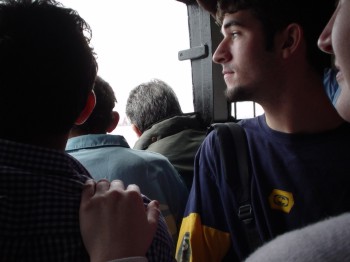After visiting the community center, we were taken to a famous alley that is the center of a Santeria community. At first we were uncertain what to do because we had no contact within the community, but we soon found ourselves well-received by people happy to discuss their traditions and artwork with us.
Members of the Santeria community invited us to a dance that was being held later that evening in a community center downtown. Many people we had seen earlier in the day were in the audience.
Two of our group members talk with one of the friends we had made earlier in the day (center).
The view of the party from outside, revealing the rather precarious porch pillars.
As a geographer, I always note transportation facilities. I was surprised to find that a container port in Havana had very up-to-date, heavy-lift cranes. If subsequently found containers being used for various purposes elsewhere in the city.
At a museum in Havana, we learned about the Yoruba gods of Western Africa, and saw this replica of an altar that would be built for a ceremony of induction into the Santeria religion, similar to a baptism.
Santeria is a synchretic religion, meaning that it blends Christian and other traditions. Yemaya is one of twelve main gods and goddesses - known as Orishas - that are found under various names in both Africa and in various parts of the Americas. I have taught about her in my introductory classes, because she symbolizes a connection to the ocean. The display to the right presents some of the many symbols of Yemaya.
Slavery is an important part of the story of African diaspora in the Americas. This display helped to make real the trauma of the Middle Passage from Africa to Cuba (and elsewhere).
In the U.S., many towns have one or two water towers for the entire town. In Mexico and Brazil, many houses have a box on the roof that serves as a micro tower for the house. In Havana, I noticed many of these mid-scale water towers serving one city block each. This seems to be a good solution, perhaps more efficient than either the large towers (which are expensive and difficult to build) or the micro towers (which require somebody's constant attention to keep water in them).
We left the museum on a local ferry that crosses part of Havana Harbor. It was probably operating at double its intended capacity -- not at all unusual for public transportation in the developing world.
It was a ferry of this kind that was hijacked from Havana Harbor on April 2, 2003. Of course, it is not allowed to have enough fuel for the crossing to Florida, so it stopped in the Florida Straits. The hijackers were executed within a couple of weeks of the event, adding to already heightened tensions between the U.S. and Cuban governments.

Photo by Tim Darling
This photo of one of our students best
illustrates the crowding on the ferry. The passengers handled it well
by being very calm - tranquilo.